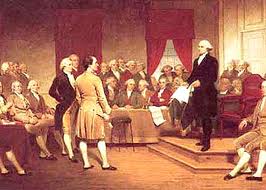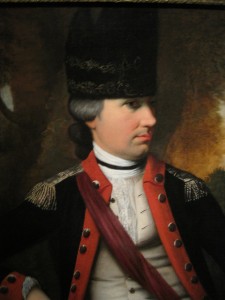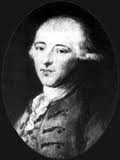
The Federal Convention of 1787
The greatest single effort of national deliberation that the world has ever seen. John Adams
 It’s been called a miracle. The Federal Convention, which we now call the Constitutional Convention, was an astonishing accomplishment. There were several moments during the convention when it looked certain to fail. Tempers often grew hotter than the stifling room. Thomas Jefferson called the delegates, “an assembly of demigods.â€Â That may have been an exaggeration, but they were certainly bright and learned. They were also committed. They refused to leave until they had secured the blessings of liberty for themselves and their posterity.
It’s been called a miracle. The Federal Convention, which we now call the Constitutional Convention, was an astonishing accomplishment. There were several moments during the convention when it looked certain to fail. Tempers often grew hotter than the stifling room. Thomas Jefferson called the delegates, “an assembly of demigods.â€Â That may have been an exaggeration, but they were certainly bright and learned. They were also committed. They refused to leave until they had secured the blessings of liberty for themselves and their posterity.
It was an unusually hot summer for Philadelphia, and for a few weeks there was an infestation of big black flies that buzzed around the delegates eyes. To facilitate deliberation, the delegates voted for secret proceedings. The intent was to promote open debate and allow the delegates to change their minds, but it also meant that the windows were nailed shut and the doors remained closed. The stench of stale sweat and absence of any air circulation made the chamber extremely unpleasant.
The first hurdle they had to overcome was getting agreement to go beyond their instructions from Congress. The instructions said that the convention was meeting for—“the sole and express purpose of revising the articles of confederation.â€Â With a little parliamentary maneuvering, the delegates reset the goal of the convention. They agreed that “a national government ought to be established, consisting of a supreme legislative, a supreme executive, and a supreme judiciary.â€Â In one audacious move, they voted to unshackle themselves from the Articles of Confederation.
The debates were long, and at times acrimonious. Worse, they had to do everything twice. At the start, they convened as a Committee of the Whole. This means the entire assembly was declared a committee. This was like a dress reversal because committees cannot adopt measures, only make recommendations. During the Founding, this was a common parliamentary maneuver for controversial issues. It allowed the weaker side to vent, and prepare a stronger argument to support their side. This exercise helped to build unity after everything was said and done.
 During these dual deliberations, the convention had to choose between competing plans. The Virginia Plan had the support of the large states, while small states pushed for approval of the New Jersey Plan. Alexander Hamilton proposed another plan that approximated the mixed parliamentary/royal system of Great Britain, and Charles Pinckney of South Carolina proposed a shockingly democratic plan. Going into the convention, the Virginia Plan looked to have insurmountable momentum behind it. The two largest and richest states, Virginia and Pennsylvania, met daily to plot the passage of this plan, which could be legitimately called the James Madison Plan. The small states believed the Virginia Plan would be a death knell for the states, so they fought furiously, first with delaying tactics, and then with the New Jersey Plan.
During these dual deliberations, the convention had to choose between competing plans. The Virginia Plan had the support of the large states, while small states pushed for approval of the New Jersey Plan. Alexander Hamilton proposed another plan that approximated the mixed parliamentary/royal system of Great Britain, and Charles Pinckney of South Carolina proposed a shockingly democratic plan. Going into the convention, the Virginia Plan looked to have insurmountable momentum behind it. The two largest and richest states, Virginia and Pennsylvania, met daily to plot the passage of this plan, which could be legitimately called the James Madison Plan. The small states believed the Virginia Plan would be a death knell for the states, so they fought furiously, first with delaying tactics, and then with the New Jersey Plan.
A deadlock was finally broken with the Great Compromise. Initially proposed by Roger Sherman of Connecticut, this compromise gave each state an equal number of Senators. The South liked it because they could use the Senate to stop anti-slavery legislation, and the small states in the north liked it because an equal voice in the upper house would protect state sovereignty.
The Great Compromise did not settle everything. In fact it only resolved the large state/small state issue. Once the Senate had been restructured, the convention had to revisit all three branches and make adjustments to retain the philosophy of checks and balances. Presidential powers consumed weeks because the delegates wanted to preclude an elected king. Slavery was an ongoing issue. Many in the North wanted to put slavery on the path to extinction. After a lot of arguing, the anti-slavery forces succeeded in getting a ten dollar per person tax on imported slaves and a total stop to the slave trade by 1808. One of the last issues was the capital. They wanted the national government independent of the states, so they added a stipulation that a new ten-mile square capital district would be carved out of somewhere.
 None of this was easy. Pierce Butler, a delegate from South Carolina said that the manners, mode of thinking, and interests of the North and South are “as different as the interests of Russia and Turkey.â€Â The newspapers of the time were full of opinion pieces that suggested the convention should form two or three different countries. Some inside the chamber agreed, but Washington, Madison, and Hamilton continued to fight for a single nation built on first principles.
None of this was easy. Pierce Butler, a delegate from South Carolina said that the manners, mode of thinking, and interests of the North and South are “as different as the interests of Russia and Turkey.â€Â The newspapers of the time were full of opinion pieces that suggested the convention should form two or three different countries. Some inside the chamber agreed, but Washington, Madison, and Hamilton continued to fight for a single nation built on first principles.
In 1787, the Founders endured a nasty summer indoors arguing the same issues over and over again until they came to a resolution. Despite all the hardships and disagreements, they never gave up.  George Mason told the convention, “It cannot be more inconvenient to any gentleman to remain absent from his private affairs, than it is for me; but I will bury my bones in this city rather than expose my country to the consequences of a dissolution of the convention without any thing being done.â€Â The Founders felt an obligation to their fellow citizens and to posterity. They wanted to build a republic for the ages.
It was important to them, and it should always remain important to us.
James D. Best is the author of Tempest at Dawn, a novel about the 1787 Constitutional Convention.
 The posts are coming!
The posts are coming!

1 comment
[…] The Federal Convention of 1787 […]
Leave a Comment